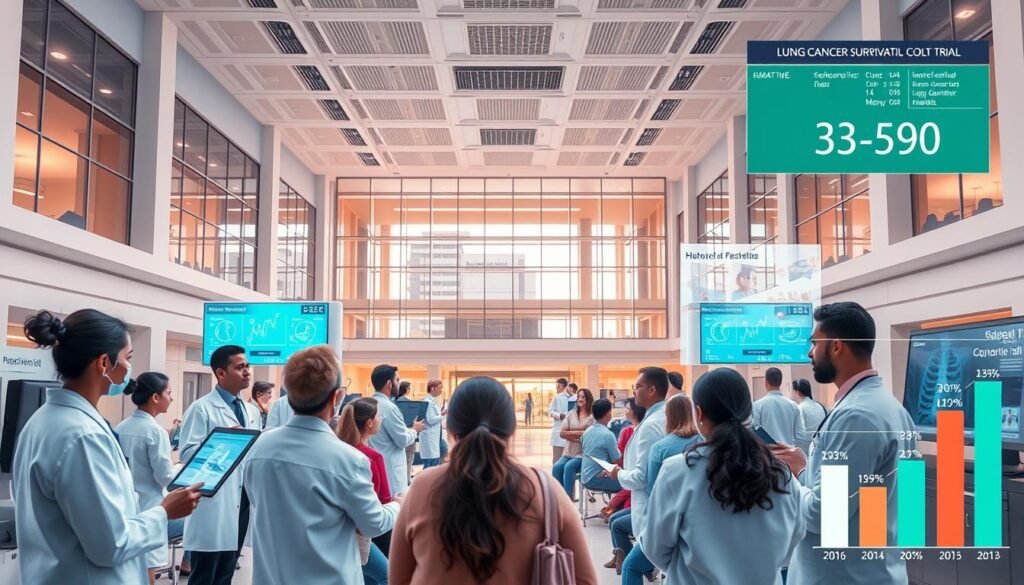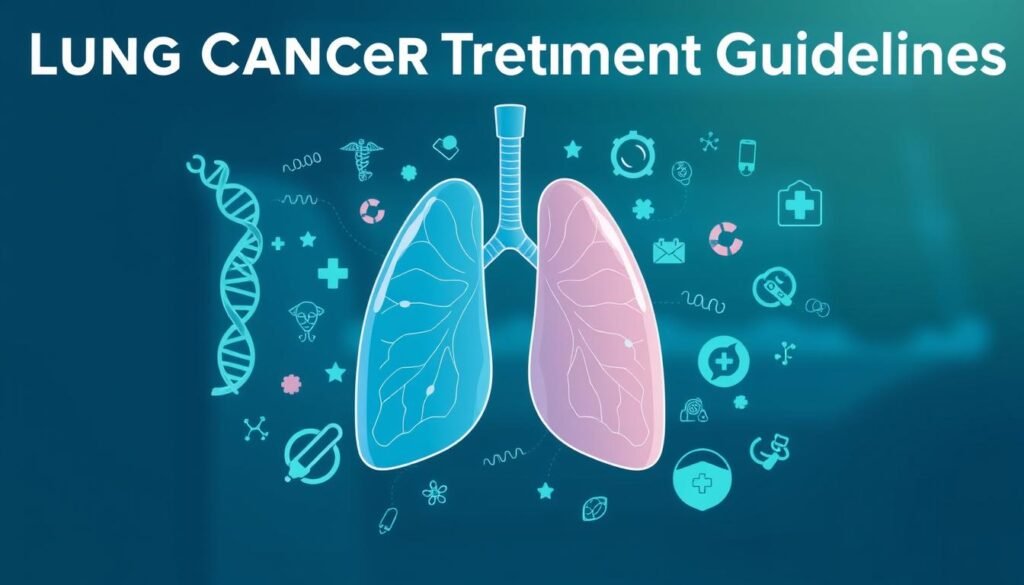Did you know that durvalumab can significantly help patients with stage III lung cancer? Recent studies show these patients have a better chance of survival compared to others. They have a hazard ratio of 0.68, showing a big advantage over older treatments.
Durvalumab is a new hope in lung cancer immunotherapy. It’s particularly effective for advanced lung cancer. Its benefits go beyond just survival rates. This treatment is changing how we care for lung cancer patients.
Looking into durvalumab’s effectiveness is crucial for future breakthroughs. This article will cover how it works, major trial outcomes, and the latest on treatment guidelines. So, we see the path to new discoveries in cancer care is opening up.
Key Takeaways
- Durvalumab has shown improved overall survival rates in advanced NSCLC patients.
- It offers promising progress in the realm of immunotherapy for lung cancer treatment.
- Recent studies highlight hazard ratios indicating significant advantages over placebo.
- Clinical trials have been vital in establishing durvalumab’s effectiveness.
- Ongoing research is crucial for the advancement of lung cancer therapies.
Introduction to Durvalumab and Lung Cancer
Durvalumab is a big step forward in treating lung cancer. It’s a type of antibody that blocks PD-L1. This helps the immune system attack cancer cells better. It offers hope to people with advanced NSCLC.
Lung cancer is a leading cause of death from cancer, especially in the United States. We need better treatments to help people live longer, better lives. Advanced NSCLC is tough to deal with because it’s often found too late.
In the past, options for advanced lung cancer were limited. But now, immunotherapy like durvalumab changes the game. It uses our immune system to fight the cancer. This new method is a big deal for people with lung cancer.
Understanding Non-Small Cell Lung Cancer (NSCLC)
Non-Small Cell Lung Cancer, known as NSCLC, is the most common type of lung cancer. It includes adenocarcinoma and squamous cell carcinoma. In the U.S., about 234,580 new lung cancer cases will be identified in 2024. These numbers show the challenges in treating and finding lung cancer early.
About 30% of NSCLC patients are diagnosed at an advanced stage III. Traditional treatments like chemotherapy and radiotherapy have their limits. This has spiked interest in new treatments, like immunotherapies including durvalumab.
Stats show durvalumab treatment can lead to a median progression-free survival of 17.4 months. This is much better than the average 8.0 months seen before. Also, the median overall survival jumps to 37.0 months with durvalumab, up from 17.0 months in the past.
| NSCLC Treatment Outcomes | Durvalumab Cohort | Historical Cohort |
|---|---|---|
| Median Progression-Free Survival (PFS) | 17.4 months | 8.0 months |
| Median Overall Survival (OS) | 37.0 months | 17.0 months |
| Common Histologic Subtypes | Adenocarcinoma, Squamous Cell Carcinoma | Not Applicable |
| Median Age of Patients | 65.3 years | Not Applicable |
The fight against NSCLC is progressing, showing why we need better treatments. By focusing on overcoming challenges, we can help improve survival for lung cancer patients.
Mechanism of Action: How Durvalumab Works
Durvalumab is a key player in treating non-small cell lung cancer (NSCLC). It works by acting as a PD-L1 inhibitor. This role is critical in boosting the body’s fight against cancer. By stopping PD-L1 from connecting with its receptors, it energizes T-cell activity. This lets the immune system better identify and attack cancer cells.
This form of immunotherapy is crucial after chemoradiotherapy. It strengthens the treatment’s impact, leading to a stronger immune response. Patients seeing these benefits suggest durvalumab’s value in cancer therapy.
Durvalumab’s treatment cycle is every 14 (2 weeks) or 28 days (4 weeks). It’s given via an IV, usually within an hour. The length of treatment depends on how well it works and its side effects. Key side effects include troubles with breathing, infections, and stomach issues. Knowing these effects helps in judging durvalumab’s long-term use.
| Side Effects | Occurrence |
|---|---|
| Common (More than 10 in 100) | Lung problems, upper respiratory tract infections, high temperature, diarrhea, abdominal pain |
| Occasional (1 to 10 in 100) | Flu-like symptoms, muscle pain, hoarse voice, swelling of hands, liver function changes |
| Rare (Fewer than 1 in 100) | Severe muscle weakness, high glucose levels, bladder irritation, meningitis |
The creation of durvalumab marks a move towards personalized medicine. It helps doctors create specific treatment plans based on individual genetics. This approach aims for better results against lung cancer. To discover more about innovative treatments, examining targeted therapies is recommended.
Overview of the PACIFIC Trial
The PACIFIC trial is a major study focusing on testing durvalumab. This therapy is for patients with a specific type of lung cancer. The study checked if durvalumab is better than a placebo for patients who did well after chemoradiotherapy.
This trial made sure patients were fairly split into two groups. One got durvalumab, the other a placebo. All had a certain lung cancer and had finished certain treatments without their cancer getting worse.
Patients got their assigned treatment as extra therapy. The study looked at survival, how long before the cancer got worse, and any side effects. The durvalumab group lived about 47.5 months on average. That’s much longer than the placebo group’s 29.1 months.
Also, more people in the durvalumab group were alive after 5 years. This was a significant finding. These results have really influenced how doctors treat this lung cancer. For more information about the trial and the scientists involved, click here.

| Parameter | Durvalumab Group | Placebo Group |
|---|---|---|
| Median Overall Survival (OS) | 47.5 months | 29.1 months |
| Estimated 5-Year OS Rate | 42.9% | 33.4% |
| Median Progression-Free Survival (PFS) | 16.9 months | 5.6 months |
| Estimated 5-Year PFS Rate | 33.1% | 19.0% |
Durvalumab Lung Cancer Survival Rate: Latest Findings
Recent research on durvalumab is quite striking. It shows its major effect on survival rates for those with limited-stage small cell lung cancer (SCLC). We’ve seen big improvements in survival when looking at durvalumab against placebo treatments. This gives us vital info on the value of this therapy.
Key Survival Statistics
In the ADRIATIC trial, durvalumab extended median overall survival to 55.9 months. This is compared to 33.4 months for placebo patients. Such a difference points to a 27% lower risk of death for those treated with durvalumab.
At three years, 62.1% of patients receiving durvalumab with cranial irradiation were alive. Meanwhile, 50.2% who didn’t get the irradiation also saw benefits from durvalumab.
Comparative Analysis with Placebo
For those in the durvalumab group, progression-free survival jumped to 16.6 months. This is versus 9.2 months for the placebo group. This boost reflects a 24% lower chance of the disease getting worse or death happening. Durvalumab clearly offers patients longer lives and better quality of life when stacked against placebo.
This trial’s results not only show durvalumab’s promise but also hint at its future role in treating limited-stage SCLC. There’s also crucial data on side effects, emphasizing the need for careful monitoring during treatment. Fortunately, durvalumab’s safety profile is seen as generally good.
To get a fuller picture of durvalumab’s survival benefits compared to placebo, dig into the full study outcomes. It could help reshape how we tackle lung cancer treatment. For more, explore this groundbreaking study to see durvalumab’s clinical promise.
| Measurement | Durvalumab | Placebo |
|---|---|---|
| Median Overall Survival (months) | 55.9 | 33.4 |
| Overall Survival Rate at 36 months (%) | 62.1 | 50.2 |
| Median Progression-Free Survival (months) | 16.6 | 9.2 |
| Hazard Ratio (overall survival) | 0.73 | – |
| Hazard Ratio (progression-free survival) | 0.76 | – |
Long-term Outcomes and Survival Rates
Durvalumab has improved long-term survival for stage III non-small cell lung cancer patients. Those who had chemoradiotherapy and then took durvalumab saw great benefits. This part talks about these survival numbers and compares them to past data.
Progression-Free Survival (PFS) Enhancements
The PACIFIC trial showed durvalumab really helps patients live longer without their cancer getting worse. Here are the details:
| Parameter | Durvalumab (Imfinzi) | Placebo |
|---|---|---|
| Median Overall Survival (OS) | 47.5 months | 29.1 months |
| 5-Year OS Rate | 42.9% | 33.4% |
| Median PFS | 16.9 months | 5.6 months |
| 5-Year PFS Rate | 33.1% | 19% |
| Patients with Grade 3 or 4 Adverse Events (AEs) | 30.5% | 26.1% |
Durvalumab has clearly improved survival rates, especially in keeping patients cancer-free longer. At the five-year checkpoint, 33% of those on durvalumab didn’t see their cancer progress. Before, only 15-30% could expect to live that long. The PACIFIC trial’s results mark a big step forward, showing durvalumab makes a real difference in life quality.

Subgroup Analyses: Factors Affecting Survival
The PACIFIC trial has shown us key factors that affect how lung cancer patients respond to treatment. These include the level of PD-L1, the patient’s age, and their smoking history. Understanding these factors helps us see how the drug durvalumab works for different people.
For those with high PD-L1 levels, durvalumab really helps. It improves how long they live. Especially if they got the drug after other treatments. This tells us how crucial PD-L1 is in fighting lung cancer.
The study also looked at how combining chemotherapy drugs affected survival. Patients who got carboplatin with durvalumab lived longer than those who got cisplatin. The survival rate after 3 years was 65.3% for carboplatin users, which was higher than 52.1% for cisplatin users.
Younger patients seemed to do better with durvalumab. Older patients faced more challenges, which affected their survival. So, age and PD-L1 levels together are important areas for more research.
Another important discovery was about previous brain radiation therapy. Patients who had it lived longer than those who didn’t. This shows us how past treatments can influence how well new ones work.
In summary, this trial teaches us a lot about what affects survival in lung cancer treatment. Knowing more about PD-L1, chemotherapy, age, and past treatments helps doctors improve care for their patients.
Current Treatment Guidelines and Recommendations
The world of lung cancer treatment is always changing. Now, lung cancer treatment guidelines include durvalumab as key. After chemoradiotherapy, it’s a top choice for stage III non-small cell lung cancer (NSCLC) that can’t be surgically removed. Top health groups say it’s vital to follow these rules to get patients the best, proven treatments.
To use durvalumab, doctors must pick patients carefully. They look for those who will most benefit from this immune-boosting drug. Doctors need to stay up-to-date on the guidelines. These help them decide who should get the drug, based on how patients respond and a thorough check before starting treatment.
New research shows durvalumab can greatly improve survival for certain patients. For example, one study shows patients on durvalumab lived about 55.9 months. This is much longer than the 33.4 months for those who got a placebo. This shows why following these treatment plans is so critical in caring for lung cancer patients. Giving personalized care means those with lung cancer get the most effective treatments available.

Future Research Directions in Lung Cancer Treatment
The landscape of lung cancer research is changing with a focus on future directions to improve patient outcomes. Researchers are checking how effective durvalumab is in clinical trials. They are especially interested in combining it with other drugs like tremelimumab. These studies are trying to find ways to increase effectiveness and help patients live longer.
Personalized medicine is becoming a key part of lung cancer research. Scientists are looking for new biomarkers to tailor treatments to each person. This custom approach improves the chance of success. For example, patients with high levels of PD-L1 see better results with durvalumab.
Moreover, scientists want to see the effects of mixing durvalumab with other treatments. This could lead to major advances in lung cancer care. Research shows that durvalumab after chemoradiotherapy extends the time patients live without their cancer getting worse to about 20.9 months. This highlights the need for ongoing research and new ideas in clinical trials.
Future research will aim to perfect treatment plans by looking closely at genetics, patient backgrounds, and past treatments. Getting more data from different types of patients will help. This knowledge is essential for developing effective treatments for lung cancer in the future.
Conclusion
The study of durvalumab for lung cancer shows promising progress in treatment options. Patients now have a chance for better survival. 42.9% of those treated with durvalumab lived for five years compared to 33.4% in the placebo group.
This marks a significant step forward in lung cancer care. It means more effective treatments are now available. Additionally, patients treated with durvalumab saw a longer time without their cancer getting worse.
33.1% remained progression-free at five years, versus 19% in the placebo group. This proves durvalumab’s effectiveness, especially for certain lung cancer patients. These results suggest durvalumab could greatly improve treatment outcomes.
The ADRIATIC study’s outcomes are very hopeful. They suggest durvalumab might become the new standard treatment. This could mean better care and life quality for lung cancer patients. To learn more about this exciting research, visit this link.